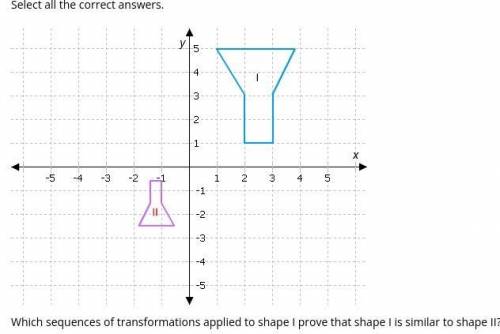
Mathematics, 07.12.2021 01:00 brennarfa
PLEASE HELP. Select all the correct answers.
Which sequences of transformations applied to shape I prove that shape I is similar to shape II?
reflection across the x-axis, followed by a reflection across the y-axis, and then a dilation by a scale factor of 0.5
a 90° counterclockwise rotation about the origin, and then a dilation by a scale factor of 0.5
a 180° counterclockwise rotation about the origin, and then a dilation by a scale factor of 0.5
a translation 2 units down and 5 units left, and then a dilation by a scale factor of 0.5


Answers: 2
Another question on Mathematics

Mathematics, 21.06.2019 16:00
Which term best describes the association between variables a and b? no association a negative linear association a positive linear association a nonlinear association a scatterplot with an x axis labeled, variable a from zero to ten in increments of two and the y axis labeled, variable b from zero to one hundred forty in increments of twenty with fifteen points in a positive trend.
Answers: 2

Mathematics, 21.06.2019 17:00
Asocial networking site currently has 400,000 active members, and that figure is predicted to increase by 32% each year. the following expression represents the number of active members on the site after t years.
Answers: 1

Mathematics, 21.06.2019 20:00
Wich statement could be used to explain why the function h(x)= x^3 has an inverse relation that is also a function
Answers: 3

Mathematics, 22.06.2019 02:30
Researchers are conducting experiments to determine the role of alcohol in the development of depression. after the study is complete, they determine that the relative risk of developing depression is 1.55 with a 95 % ci of 1.2 -1.9. each group is then divided into nonsmokers and smokers. the relative risk for the nonsmokers is 1.12 with a 95% ci of 0.87-1.37. the relative risk for the smokers is 1.7 with a 95 % cl of 1.5-1.9. what type of bias may affect this study? a. procedure bias b. recall bias c. selection bias d. confounding e. lead-time bias
Answers: 2
You know the right answer?
PLEASE HELP. Select all the correct answers.
Which sequences of transformations applied to shape I...
Questions





Mathematics, 13.12.2019 23:31



English, 13.12.2019 23:31





Social Studies, 13.12.2019 23:31


History, 13.12.2019 23:31

Mathematics, 13.12.2019 23:31

Chemistry, 13.12.2019 23:31





